[display-name-category]
[post_author]
Lately, I’ve talked with a lot of advertisers who are looking to write the perfect ad for their business.
Writing Google Ads is one of those things that are incredibly simple but somehow still take a long time to get right.
Today, I will start a new series that will teach you how to write powerful ads for Google AdWords. I will start out with the headline and then move on to the other components of ad writing.
There are four components that go into every single ad:
- Headline
- Description
- Display URL
- Landing Page
The ways to tackle each of these components depend on what you’re trying to sell and essentially what type of business you are.
Whatever you do, ensure that you don’t make the 8 most common ad writing mistakes that I’ve seen over the years:
- Not Utilizing The Top Ads Format
- Not Testing Your Ad Copy
- Using Overly Specific Ad Text for Generic Keywords
- Repeating Yourself In Your Ad Sitelinks
- Thinking You Can “Skip” a Period, Letter or Space
- Breaking Your Ad Text Where It Doesn’t Make Sense
- Copying Your Competitors, or Not Noticing You Have Been Copied
- Having Outdated Ad Text
The examples in this blog post are focused on local businesses, but the blueprint can be used for all advertisers.
The ‘Keyword In The Headline’ Best Practice Doesn’t Hold Up Anymore
One of the oldest tips for writing headlines for Google AdWords ads is to include your keyword. However, towards the end of 2014, we started seeing that one of the main benefits of this best practice no longer applied.
Back in the day, when a search term matched a word in a Google AdWords ad, it would be highlighted:
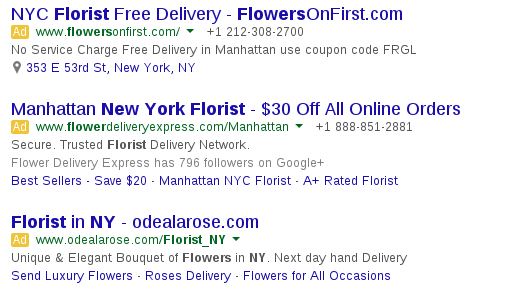
However, if I perform the same search today in early 2015, none of the keywords are highlighted:
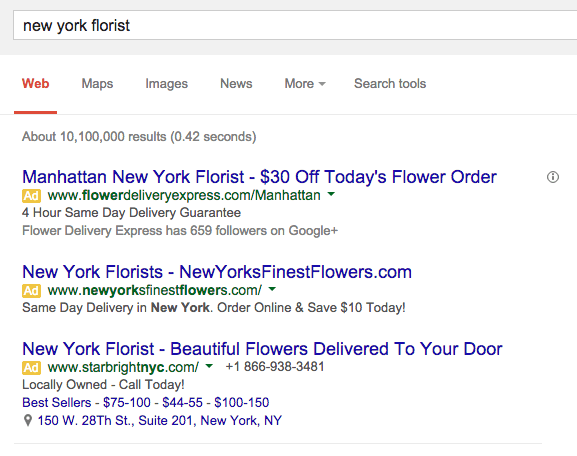 As you can see, the landscape has changed and it’s not as effective to include your keyword in your headline as it used to be. Like Larry Kim of Wordstream writes in his excellent post The Secrets Behind Ads with 3X CTR, you can potentially achieve more with your ads when you don’t include the keyword.
As you can see, the landscape has changed and it’s not as effective to include your keyword in your headline as it used to be. Like Larry Kim of Wordstream writes in his excellent post The Secrets Behind Ads with 3X CTR, you can potentially achieve more with your ads when you don’t include the keyword.
When it comes to writing an effective Google Ads headline, the goal should, therefore, not be to try to squeeze your keyword in as many times as possible but to get the appropriate emotional response from your audience.

My Best Headline Hack: Only Include Part of Your Ad Group’s Main Keyword
One of the hardest things in Google Ads is writing a headline that makes an emotional impact. You have so few characters (25 to be exact). My recommendation is to only include part of a keyword, as it will give you more flexibility to stand out.
Let me give you an example. You have the following keywords in an ad group:
- plumber fast quote
- plumber near me
- local plumbers
Normal practice in such an ad group would be to use Dynamic Keyword Insertion. This would insert your keyword in the headline as they get triggered. That’s beneficial as it ensures relevancy between keyword and ad. However, it’s also what everybody else is doing:
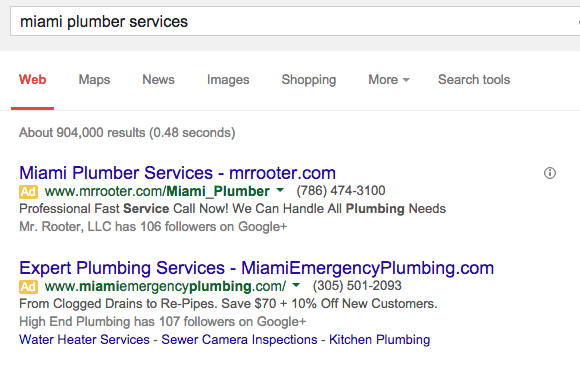
Who would you rather go for in this example? Mr. Rooter has the exact thing you’re looking for, but Miami Emergency Plumbing is experts. What headline stirs the most emotion in you?
Blueprint to Construct Your Headline
This is where ad writing becomes more of art instead of just filling in the blanks. Depending on what your main keyword is, you will have between 20 characters and 5 characters to use once you have inserted your main keyword.
Obviously, if you only have 5 characters left, your options will be limited. The following list is to get your creative ideas flowing and come up with the best possible headlines:
Short Words When You Don’t Have Much Space
- Buy
- Get
- Call
- Shop
- See
- Try
- Come
- Book
Specific adjectives
- Better
- Emergency
- [City Name]
- 24/7
Price-Focused
- Sale
- Deals
- 50% off
- Cheap
- Affordable
- Low Cost
To Invoke Trust
- Expert
- Specialist
- Certified
- Licensed
- Insured
- Trusted
- Reliable
- Dependable
Match Your Headline With The Audience You Want to Attract
A common mistake is that advertisers get lost in ad writing. You find so many good ideas and cool adjectives, and at the end of the process your ad looks very good – it just doesn’t fit your company message.
One of the classic examples is when companies have ads promising “cheap XYZ services”, but they aren’t actually cheap compared to their competitors. A lot of people searching on Google are attracted to cheap pricing ads. If you write that you have low prices, you’re likely to get a pretty good CTR.
However, when visitors come to your website (or invest the time to call you), it will prove to be not only a waste of money but also a waste of human resources, as you had to attend to that potential customer who had no intention to buy your service once he discovered your pricing.
Pricing is just one factor with which you can attract the wrong audience. You can go wrong in many different areas, so always keep the end-customer that you’re trying to attract in mind. If you have a high-end product or service, you should always expect a lower CTR than if you have a low-end product. That’s the nature of high-end vs low-end products. There are a lot more potential buyers for low-end products than for high-end products.
When to Use Dynamic Keyword Insertion in Headlines
Oh, Dynamic Keyword Insertion, the crazy party friend you love to call in the beginning stages of your friendship, but who, as you mature as a person (i.e. grow up) you rarely call anymore.
That’s honestly the best way to describe Dynamic Keyword Insertion (DKI). Don’t get me wrong. DKI can be very powerful when used correctly, but too many advertisers use it too much.
There are essentially only two scenarios in which DKI is a good tactic to improve your ad performance:
- You have a lot of minor keywords that are closely related.
A great example is keywords with location keywords (i.e. cities, zip codes, etc.) or product SKUs. It can be grueling to create an ad group for each of these keywords (and generally not worth your time), but you don’t want to risk a low CTR.
In such a case, setting up the initial ad groups with the use of Dynamic Keyword Insertion can help you obtain a good CTR.
- You need to test search volume on a lot of keywords.
I’m not a big believer in the Google AdWords Keyword Planner or other search volume prediction tools. Ever since I inserted the keyword “cheap iPhone” into the keyword planner and it came up empty, I haven’t had much faith in it.
One of my guiding principles for keyword research is to test the search volume and not make any assumptions based on search volume prediction tools.
When I add 100 widely different keywords to a Volume Testing ad group, I need to use DKI. If I don’t use DKI, I risk the Quality Score becoming too low, and my keyword will not trigger any ads. This will lead me to falsely believe there are no searches for the keyword.
The Dangerous, But Beautiful Way To Writing Headlines
There is one last way to write Google AdWords headlines that I want to talk about. It’s the practice of writing headlines that don’t include the search terms used by the searcher but instead should work to attract their search.
Let me give you a couple of examples. If a consumer searches for running shoes for men, you’ll find the following best practice ads:
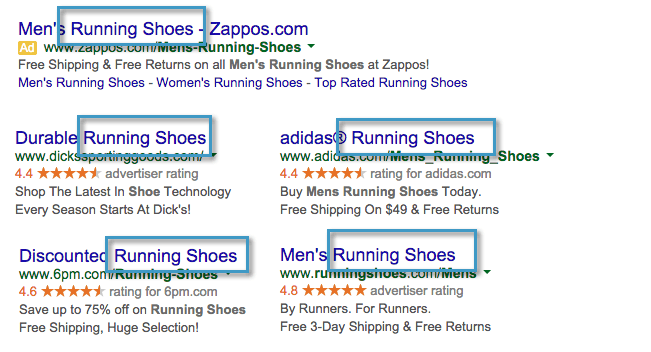
But at the same time, you will also find a new type of ad – a type of ad that you haven’t been recommended to write for a long time:
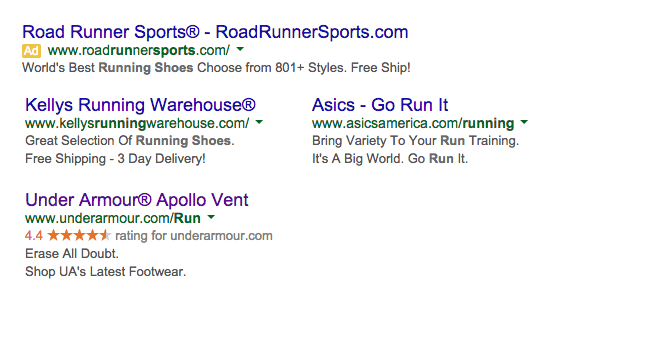 If you had asked me a year ago, then I would have abruptly told you that the ads from UnderArmour, Asics, and Road Runner Sports were no good. I would have said that they were the work of some “modern” ad agency with no sense of how Google AdWords is supposed to be managed.
If you had asked me a year ago, then I would have abruptly told you that the ads from UnderArmour, Asics, and Road Runner Sports were no good. I would have said that they were the work of some “modern” ad agency with no sense of how Google AdWords is supposed to be managed.
However, you’re asking me today I will give you a different answer.
Testing Headlines Without The Main Keyword
I have tested these headlines for some time now, both in low volume accounts, our White Shark Media® account, and high volume client accounts.
You know what? They can actually work, but they can also fail miserably.
I have seen that in ~60% of my tests, I didn’t manage to achieve better performance by not using the keyword. Of course, just removing the keyword was not the objective; instead, it was to free up characters to write a more enticing headline.
My recommendation is to try it out, but be careful. When you try out such different ads, you should monitor them more closely. If the ad doesn’t work, your CTR can decrease. At the end of the day, it’s very important that you write a better ad and don’t just think that by taking out the keyword from the ad headline, then you will automatically get better results.
I also have a thesis that the better known your brand is and the more it relates to what the searcher is looking for, the better results you will get by using the “no keyword” approach to headline writing. It’s only natural that if your brand is commonly known for having top-notch running shoes, then your name lets searchers know that they can find running shoes on your website without spelling it out.
Biggest Headline Writing Takeaway
The landscape of what constitutes a good AdWords Headline has shifted. It is no longer limited to inserting your main keywords in your headline or using Dynamic Keyword Insertion.
In fact, my biggest advice is that you avoid following a strict set of rules when writing your headlines. Regardless of your business type, put your focus on triggering an emotional response from your potential customers and in that way match your headline with the audience you wish to attract.






